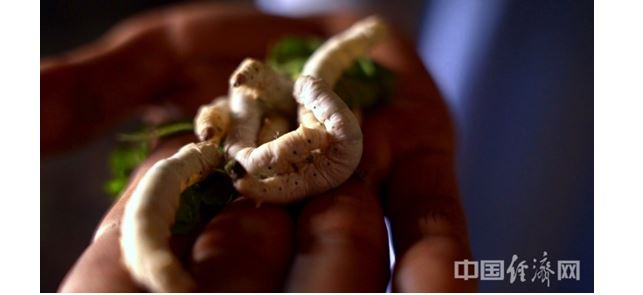ISLAMABAD, May 27 (DNA): Sericulture might be a big source for farmers to boost income, says a report published by China Economic Net (CEN) on Friday.
“We’ve earned Rs 70,000 in one month. However, if I work elsewhere, even with my kids, I can’t earn that much,” said Muhammad Aslam, a silkworm farmer in Changa Manga, Punjab.
Aslam’s income came from raising silkworms. It took 45 days from buying silkworm eggs to hatching, silking and selling cocoons. “As there are five in our family, we can raise two packets (one packet contains 3,000-4,000 silkworm eggs) in one season.”
He told CEN cheerfully that “we’ve used this income to cure my kids’ eye troubles and buy new clothes for them.”
Most families in Changa Manga where Aslam lives were poor in the past. Some families used to have an average daily income of less than Rs 500, which was below the World Bank’s poverty line of USD 3.2 (about Rs 588) per capita per day in Pakistan.
Many poor households have now started raising silkworms to earn a living. “This spring families around us raised about 1,500 packets. Many people used to ride bicycles, but now they bought motorcycles after raising silkworms. Moreover, some are capable of paying for their children to go to school and get married,” Aslam said.
According to the report, each family earns Rs 150,000 more per year by introducing Chinese silkworm eggs
Back in 2018, farmers in Punjab were mostly breeding Bulgarian silkworms. In scorching summer, it was well above the optimal temperature of 25°C for silkworm cultivation. This meant that there was only one season a year when silkworms could be raised for money, with limited increase in income.
“Since that year, we have imported Chinese silkworm eggs, which are of better quality. With good yield and resistance, they can be raised in both spring and autumn.
That year, 300 packets of silkworm eggs were imported, and the import was increased to 600 packets in 2019,” said Muhammad Farooq Bhatti, deputy director, Sericulture, Forest Department Punjab, adding that “1,000 families in Changa Manga started raising silkworms this year.”
For rural Pakistani families, silkworm raising takes up little time and brings in significant additional income. As silkworms feed on mulberry leaves mainly in the last seven days (over 85 percent of their total mulberry leaf intake), farmers are generally supposed to pick mulberry leaves frequently to feed silkworms during these seven days, and they can continue other farm work such as raising cattle and planting crops in the rest of the time, Bhatti explained.
In terms of the income of raising a packet of silkworm eggs, according to Bhatti, the purchase cost is Rs 2,000-2,500, and the output is 35-40 kg of cocoons. As the price of cocoon is Rs 1,200-1,300 per kg, the income is Rs 30,000-40,000.
Mulberry trees required for silkworm breeding are planted by the government, and the mulberry leaf picking fee is Rs 150 a season. If a family, including four or five people such as husband, wife, children and grandparents, raises three packets of silkworm eggs, the income can reach Rs 80,000-90,000. If they raise two seasons a year, the income will hit Rs 150,000, with an average increase of Rs 12,000-15,000 per month.
With the improvement of farmers’ skills in raising silkworms, cocoon production is expected to double. He Yubing, the Chinese head of Buraq Import Export (pvt) Ltd., a company that provides cocoons, said the same type of silkworm can produce 50-60 kilograms of cocoons in China, which is about 1.5 times it produces in Pakistan.
One acre of land supports ten packets of silkworm eggs by introducing dwarf mulberry trees. For silkworm farmers, in addition to silkworm, mulberry tree is another key factor for raising silkworms. Silkworms only feed on mulberry leaves, and can take 4-5 times a day in the late age of silkworm rearing, so a packet of silkworm eggs can devour over 100 kilograms of fresh mulberry leaves. Moreover, the amount of intake affects silkworm size and cocoon production.
“For our parents’ generation, they needed to climb mulberry trees, which are about 30 to 40 feet (about 9-12 meters) high, to pluck leaves. The slightest mistake would result in a disabled fall, and some people even lost their lives.” In addition, once the autumn and winter arrive, mulberry leaves fall off, so it is impossible to raise silkworms, Aslam said.
Later, Pakistan introduced Japanese mulberry trees, but the results were not satisfactory. “The leaves of Japanese mulberry trees are rather thin, and the silkworms produce little silk after feasting on them,” said Muhammad Amin, who has been in the silk business for 10 years.
For this reason, Chinese mulberry trees were introduced by the Sericulture, Forest Department Punjab. “It has provided us with dwarf mulberry trees. We, including kids and the elderly, can pluck leaves while standing on the ground, and we have mulberry leaves in winter,” Aslam said contentedly.
Bhatti has been content with the mulberry varieties imported from China. “If the soil is appropriate, 250 quality mulberry trees can be planted on one acre of land. Besides, they grow very fast. If they are planted in January this year, they can grow big leaves in February next year.
Moreover, the mulberry trees on one acre of land can support ten packets of silkworm eggs, which means 300 kg of cocoons. In the past, it took 3 hours to pick 40 kg of leaves, now it takes 30-45 minutes, which saves 75% of labor cost.”
The development of silkworm industry can reduce poverty and increase income for Pakistani farmers. In addition, with Pakistan’s depleting foreign exchange reserves, there is of great realistic significance, as it can promote import substitution and reduce foreign exchange spending.
At the silk processing plant, Muhammad Yaseen, a silk producer, was busy drying the cocoons and soaking them in hot water to turn them into raw silk. Soft, smooth and flexible, raw silk is a high-grade textile material that also has major uses in industry and medicine. “The high-quality raw silk produced from imported Chinese silkworm eggs is so fine that it will be sent to Karachi to be made into fabric for export to Dubai.”
Yaseen told the CEN that the business was more common two decades ago. It is disappearing today, mainly due to the scarcity of silkworm eggs, which, despite having started to be imported, are still not enough. “If Pakistan is able to produce enough cocoons, we don’t need to import them from Afghanistan.”
The shortage of cocoons also restricts foreign investment and the development of silk reeling industry. He Yubing told the CEN that as early as 2018, a Chinese company from Zhejiang Province visited Punjab to establish a silk quilt factory, requiring an annual supply of at least 100,000 kilograms of cocoons.
However, the cocoon production in Punjab was far from enough at that time. Even today, cocoon production is around a few thousand kilograms. He Yubing hoped to further promote the sericulture industry, “our goal is to train 40,000 silkworm farmers and increase cocoon production to 4 million kilograms within five years.”
Pakistan has a great demand for raw silk and cocoons. “We spend a lot of foreign exchange every year to import raw silk and cocoons for the textile and pharmaceutical industries. If raw silk and cocoons can be produced in Pakistan, then this money can be saved. Tens of thousands of families will be employed and the poverty rate will drop significantly, especially in rural areas,” Bhatti analyzed.
According to the Pakistan Bureau of Statistics, Pakistan’s Synthetic & Artificial Silk Yarn imports were USD 720 million in the first 10 months of FY 2021-2022, up 27 percent year-on-year, surpassing the imports of USD 660 million in the entire FY 2020-2021.
In He Yubing’s view, not just import substitution, the silk industry has the potential to become a pillar industry for export like the cotton textile industry, as it has an extensive demand worldwide.
Take China’s sericulture industry as an example. China is the world’s largest mulberry silk producer and exporter, with its cocoon and raw silk production accounting for more than 80% of the world’s total. Silk exports reached USD 650 million in 2021. Among them, cocoon production hit 407,400 tons in Guangxi in 2021, accounting for 55% of China’s total output.
How can Pakistan get more silkworm eggs and improve the productivity of sericulture industry in the future? What is the cooperation potential between China and Pakistan?
First of all, one of the biggest problems with importing silkworm eggs is taxation, Bhatti noted.
“When the goods arrive at the airport, they are subject to 17% sales tax, 12% income tax, 6% customs duty and other fees, resulting in prices that are more than 50% higher than that in China.” He said a packet of silkworm eggs costs Rs 2,000 in Pakistan, while in China, silkworm eggs are offered to farmers at USD 3-4 per packet, even in India, it is less than Rs 1,000.
“If the taxes paid in Pakistan are waived, the price of a packet of silkworm eggs provided to farmers will drop to Rs 1,000. I believe that within five years, silkworm raising will expand to 50,000 families,” Bhatti said.
In addition, it is also possible to try local breeding through professional training.
“Silkworm breeding is highly specialized and currently there is less research in this field in Pakistani universities or even agricultural universities. It will be beneficial if Pakistani experts or officials have the opportunity to receive training in China on the relevant technology or if Chinese experts can come to Pakistan for exchanges,” Bhatti said.
Bhatti looked forward to local breeding. “If we can produce silkworm eggs in Pakistan, the cost per packet is only Rs 200-300 (about 1/10 of the current price), which will help solve the problem of long-term supply.”

















